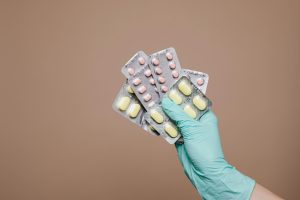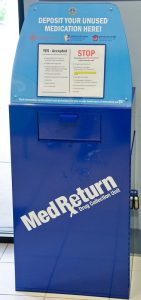In many ways, modern medicine is the backbone of the world as we know it. The development of medicines like antibiotics was a major contributor to the rapid population growth starting in the 1800s: when life-threatening illnesses can be treated by medicine, death rates fall and population grows. Medicine not only allows for people to live longer, healthier lives, but is very important for the maintenance of our food supplies, especially in animal agriculture.

But pharmaceutical drugs don’t just disappear after they have treated the problem at hand. As access to medicine increases worldwide, so does the incursion of those pharmaceuticals into the natural world. While some of those pharmaceuticals are harmless, many more are disruptive to ecosystems and have the potential to negatively affect human health. Ensuring the health of people and the planet will require a better approach to managing pharmaceuticals in the natural world after they’ve been used for their intended purposes.
Causes of Pharmaceutical Pollution
The EPA lists several different ways that pharmaceutical drugs can infiltrate the environment. Pharmaceuticals in the environment are often disseminated when they enter our natural water systems.
- Human excretion: When a person takes a medicine, not all of that medicine is absorbed by the body. The remnants of that medicine are then expelled as part of human waste. Removing pharmaceuticals from wastewater can be expensive and requires technology that few wastewater treatment plants have access to. This means that even after wastewater has been treated, pharmaceuticals are still present and find their way into water systems.
- Flushing medications: People might think that they are safely disposing of medication when they flush unwanted medicine down the toilet, but flushing medicines introduces them to the water supply. Just as with excreted pharmaceuticals, wastewater treatment plants cannot effectively remove these pharmaceuticals from the water supply. Turning in unused medicines to a pharmacy disposal location allows those medicines to be safely treated and disposed of instead.
- Landfill leachate: When pharmaceuticals are thrown into the trash instead of properly disposed of, they degrade over time and can seep into soil if the landfill is not properly lined. As these pharmaceuticals enter the soil, they can then enter groundwater and connected water systems.
- Animal agriculture: Animals that are cultivated for human consumption are often treated with medicines like antibiotics. When these animals produce waste, or when animal carcasses are not properly managed, these pharmaceuticals find their way into water systems.
Effects of Pharmaceutical Pollution
Medicines cause changes in living things; if you’re taking a medicine to help a headache or treat diabetes, you certainly want that medicine to make a change in your body. When these pharmaceuticals exist outside of their intended contexts, they can start causing changes in organisms that were never meant to be changed.
Studying the effects of pharmaceuticals on ecosystems is a relatively new field of research and is made more difficult by the sheer number of contaminants of emerging concern to be tracked. But some effects of pharmaceuticals in the environment have already become evident, especially in aquatic organisms.
Pharmaceutical Pollutants in Water
Amphibians are especially vulnerable to changes in water ecosystems because of the porous nature of their skins. The phenomenon of feminization, or when male amphibians’ sex characteristics change to resemble those of females, has long been documented as an effect of the herbicide atrazine. But feminization can occur as a result of pharmaceuticals as well, especially from the synthetic estrogens found in birth control pills. Some amphibians were found to undergo feminization at a 100% rate when exposed to estrogens.
Pharmaceutical Pollutants on Land
The negative effects of pharmaceuticals in the environment aren’t just limited to water animals, however. One of the most famous examples of how pharmaceuticals can damage ecosystems occurred in India in the “Asian Vulture Crisis.” Vultures in India went from populations of 40 million in the mid-1980s to less than 19,000 in 2017, a decline of more than 99 percent. What was the cause of this precipitous collapse? Widespread use of NSAIDs in animal agriculture. Farmers had long left cattle that had died of sickness in fields to be disposed of by decomposers like vultures. As NSAIDs became more widespread, more of these cattle were treated with NSAIDs prior to dying, meaning that vultures started ingesting NSAIDs as they fed. Because NSAIDs cause kidney failure in vultures, this led to a sharp decline in vulture populations. And while there is now better awareness of this connection, vulture populations have yet to recover.

Pharmaceutical Pollution Effects on Humans?
As for humans, there have been no observed occurrences of pharmaceuticals in the environment having directly negative impacts on human health. But humans’ health and wellbeing are directly tied to the health of the ecosystems that we live in. Even if pharmaceuticals haven’t been found to directly harm human health, humans are still affected when ecosystems are harmed.
Preventing and Treating Pharmaceuticals in the Environment
 Solutions to pharmaceutical pollution require more research into how pharmaceutical drugs affect the natural world, and this is still a relatively nascent field of research. But much more can be done to stop pharmaceuticals from negatively impacting non-human organisms. Promising wastewater treatments like oxidation and carbon filters have been found to be effective in removing non-conventional pollutants like pharmaceuticals from water, and more education and awareness of the topic can stop people from using improper disposal methods. As more people continue to take more medicine, keeping pharmaceuticals from acting upon the wrong organisms will continue to be an important part of maintaining the health of people and the planet.
Solutions to pharmaceutical pollution require more research into how pharmaceutical drugs affect the natural world, and this is still a relatively nascent field of research. But much more can be done to stop pharmaceuticals from negatively impacting non-human organisms. Promising wastewater treatments like oxidation and carbon filters have been found to be effective in removing non-conventional pollutants like pharmaceuticals from water, and more education and awareness of the topic can stop people from using improper disposal methods. As more people continue to take more medicine, keeping pharmaceuticals from acting upon the wrong organisms will continue to be an important part of maintaining the health of people and the planet.
Image credits: Blister packs of medicine (Kaboompics.com on Pexels); Vulture scavenging (SudeepKC, CC BY-SA 4.0, via Wikimedia Commons); Drug take-back container for safe pharmaceutical disposal (DDAP Drug Take Back 06_DSC4339 by Pennsylvania Nation Guard is licensed under CC BY-NC-ND 2.0)




